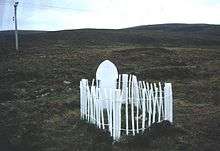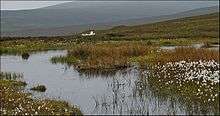Betty Corrigall
Betty Corrigall was a Scot whose body was found 150 years after her suicide and burial in an unmarked grave. Her grave is now a popular tourist site on Orkney, and she was the inspiration behind the 2012 album Orkney: Symphony of the Magnetic North by The Magnetic North.[1]

Life
Corrigall lived in Greengairs Cottage near Rysa on Hoy[2] on Orkney in the 1770s. At the age of 27[3] she had a short romance and fell pregnant. Her boyfriend, a whaler by trade, abandoned her and returned to sea. Betty had little in the way of support and it was a very Christian community, so attempted suicide only to be rescued by residents. A few days later a second suicide attempt, by hanging was successful.
Due to the laws of the land at this time the Lairds of Hoy and Melsetter would not allow her to be buried on their property[4] and she was finally laid to rest outside their boundary in an unmarked grave.

Exhumation and headstone
Her body was discovered in 1933[5] (some sources say 1936[4]) by peat diggers who came across her wooden coffin, her remains were well preserved in the peat. The procurator fiscal requested that she be buried in the same spot. In 1941 a group of soldiers dug up her body and referred to her as the Lady of Hoy. After this she was regularly dug up and quickly began to decompose. A concrete slab was therefore placed over the grave.[6]
In 1949 an American minister Reverend Kenwood Bryant visited Hoy[4] and was so moved that he asked Mr Harry Berry, a customs officer, to create a proper headstone. This eventually happened 27 years later after Mr. Berry's retirement. However, due to the boggy ground a stone headstone was unsuitable and a fiberglass one was erected instead.[7]
Betty's grave is now a popular tourist site. The headstone reads "Here lies Betty Corrigall."[8]
In popular culture
In 2013, The Magnetic North released their debut album Orkney: Symphony of the Magnetic North. Founder member Erland Cooper states that the inspiration for the making of the album came from Corrigall's appearance to him in a dream, insisting that he wrote an album about his home.[9]
Scottish band The Knowe O'Deil (of which Ivan Drever was a member) released an album called Orkney Anthem, which includes the track "Betty Corrigall".[10]
References
- "The Quietus | News | LIVE REPORT: The Magnetic North". The Quietus. Retrieved 2016-12-09.
- "betty_corrigall". www.cantickhead.com. Archived from the original on 2016-03-07. Retrieved 2016-12-08.
- "Geograph:: Hoy: the grave of Betty Corrigall (C) Chris Downer". www.geograph.org.uk. Retrieved 2016-12-09.
- "Betty Corrigall's grave - unconsecrated burials in Britain". www.thegranthams.co.uk. Retrieved 2016-12-08.
- "The Sad Tale of Betty Corrigall - The Wronged Lady of Hoy". www.scapaflow.co. Retrieved 2016-12-08.
- "Orkneyjar - Betty Corrigall's Grave". www.orkneyjar.com. Retrieved 2016-12-08.
- "Betty Corrigall | People of note | Culture and tradition | Scapa Flow Landscape Partnership Scheme". www.scapaflow.co. Archived from the original on 2014-10-21. Retrieved 2016-12-08.
- "Betty Corrigall's Grave - Hoy Orkney". Hoy Orkney. Retrieved 2016-12-08.
- Fulton, Rick (2013-07-19). "Simon Tong reveals how Orkney's rugged landscape inspired his new band to create haunting debut album". dailyrecord. Retrieved 2016-12-09.
- "Betty Corrigall, by The Knowe O'Deil". Ivan Drever. Retrieved 2016-12-09.